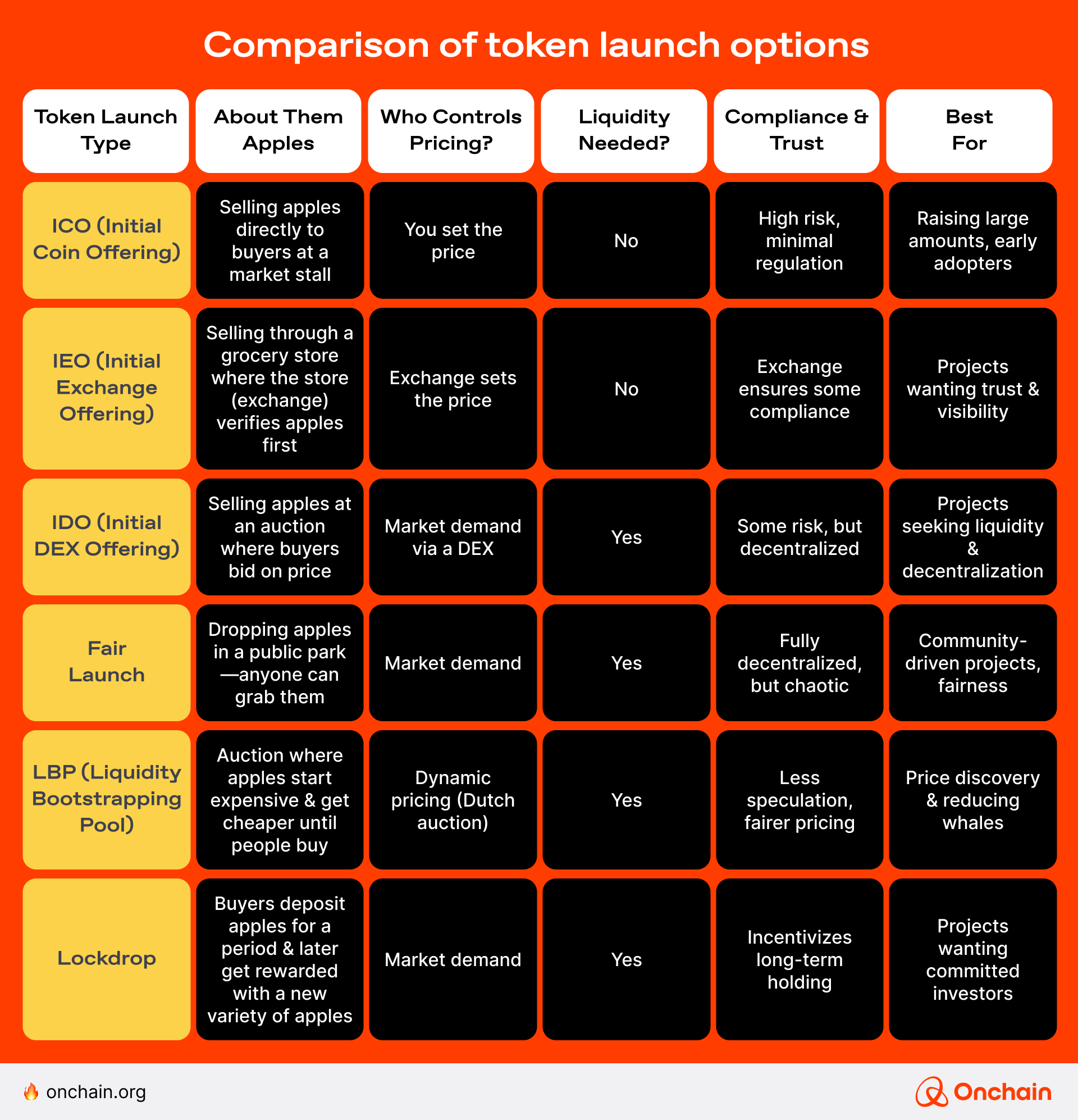Fundraising for your project is one of the most important phases of business you’ll lead as a Web3 founder. Who invests, and how, can significantly affect the long-term outcome of your project.
Today, ICOs, IEOs, and IDOs are the most well-known strategies, while newer methods like Fair Launches, Lockdrops, and LBPs are gaining popularity. In this article we’ll take a look at the strategies and break down the pros and cons of each so you can make an educated decision for your fundraising.
A rule of thumb: start preparing early. Even if fundraising seems a distant milestone, understanding your options now can help you shape and structure your project for a more effective raise when the time comes.
ICOs, IEOs, and IDOs Explained
What is an ICO — Initial Coin Offering?
The OG way to raise capital for blockchain projects. Imagine you’re an apple farmer. ICOs are like selling apples at your farm directly to the consumer. The apples look good, but no one has verified whether or not they’re ripe and worm-free.
Investors look to ICOs for both their risk and reward. The risk provides leverage for a high equity share, making the reward even greater if the project pops off.
The biggest ICO to date was that of EOS, raising over $4.1B. The reward potential was huge, but so was the risk. Block.one, the owner of EOS, was penalized $24M by the SEC soon after the raise.
Benefits of ICOs
- Get in front of investors who have an appetite for risk.
- There’s no middleman taking a cut from your raise.
- In most cases, there’s no hard cap, so your raise is only limited by reach and hype.
- Your project will have access to investors anywhere in the world.
- You can capitalize on hype, which may generate more competition in your ICO.
Pitfalls of ICOs
- You may have to do more convincing that your project is safe.
- Reach is up to you — if you don’t have a great marketing and outreach team, or solid strategic partnerships, you may not find enough investors.
What is an IEO — Initial Exchange Offering?
Then came IEOs (initial exchange offering), which emerged around 2019. An IEO is like selling your apples at a store instead of a farmer’s market. The store has verified the apples were grown by a great farmer, but customers need a membership in order to enter the store.
IEOs work with large centralized exchanges such as Binance or OKX to reach potential early-stage investors. The exchange vets the project for investors, making it a safer bet for them. However, the exchange charges listing fees to be featured on their platform, adding to your overhead.
Benefits of IEOs
- The exchange legitimizes your project.
- That legitimacy may translate to making your project more attractive to the risk-adverse, reaching new audiences earlier.
- Investors have more overall security in investing.
Pitfalls of IEOs
- Listing fees paid upfront to the exchange can effect your overall take.
- Some exchanges may want a percentage of the take or tokens as well.
- The lower risk may result in a lower raise than an ICO.
- The exchange is likely to set a hard cap to ensure a quick and full token sale, limiting what you can raise.
What is an IDO — Initial DEX Offering?
An IDO (initial decentralized offering), on the other hand, helps projects capitalize on the security of an exchange while keeping to the decentralized values of blockchain. This is selling apples to other apple farmers — no one is vetting the apples but there’s no middleman limiting how many apples you’re allowed to sell and taking a cut.
IDO offerings emerged in 2020 and leave all the power in the hands of the buyers and sellers. You won’t have to pay an exchange fee for being featured, but you will have to do the work of proving your project is worth the risk just like in an ICO.
Benefits of IDOs
- You gain worldwide reach, just like that of an ICO.
- There are no fees, no problem.
Pitfalls of IDOs
- Projects need to put up liquidity to back their token on the DEX, requiring greater initial overhead on your project’s part.
- You’ll need to prove to the public your project is safe to invest in, just like in an ICO.

The new kids on the block
Not sure you want a traditional token launch for your project? Let’s have a look at the emerging fundraising opportunities for new Web3 projects.
Fair launches: A more egalitarian approach
Fair launches are like a community apple orchard. Anyone is welcome and there are no preferred sales. Similar to IDOs, fair launches are offered without a middleman taking fees.
Fair launches may include liquidity mining, airdrops, or staking rewards.
Lockdrops: A new era of token distribution
Imagine you want apples but all you have are lemons. The apple seller is soon to begin sales at the market and is widely acclaimed in other stores. You want in, so you give your lemons to the apple seller to hold to save your spot in his early supply.
That’s a rough example of how Lockdrops work. Similar to staking to support a project, one can lock a non-native token like USDC or ETH in support of an emerging project. The longer your token is locked, the greater your reward. It’s a similar philosophy to airdrops — only those that truly support the upcoming project with skin in the game will receive the token.
Liquidity bootstrapping pools (LBPs): A dynamic and flexible option
Taking the apple-selling analogy further, LBPs begin selling their apples high. They allow project leaders to assume their apple is the best apple to ever be on the market and launch expensive. Over time, a smart contract titrates the price lower, until buying begins. At that point, the smart contract moves the price according to supply and demand, ultimately finding a token market fit for the project.
This approach provides a wide amount of access to the token. It prevents whales from buying up the supply on the cheap, only to dump it later on retail wallets. Ultimately, it keeps the project from speculation and lets the market do the work.
How to pick the right token launch for your Web3 project
So you’re ready to sell your apples — ahem, I mean, tokens. You’re confident about your supply and you’ve got good proof of demand. How do you decide on the right launch option for your project? Here are some things to consider.

Here’s a quick and dirty decision matrix:
- If you want fast funding but high risk → ICO
- If you want trust from investors & exchange support → IEO
- If you want decentralization & liquidity → IDO
- If you want fair access for all participants → Fair Launch
- If you want early commitment from investors → Lockdrop
- If you want gradual price discovery → LBP
Conclusion: Which will you choose?
I hope this helps you decide which token launch is right for you. If you are ready to take action, you’ll love the next article. There, we break down launch strategies that you can apply to your business model to give it that edge it deserves. Click the arrow below to learn all about it.



